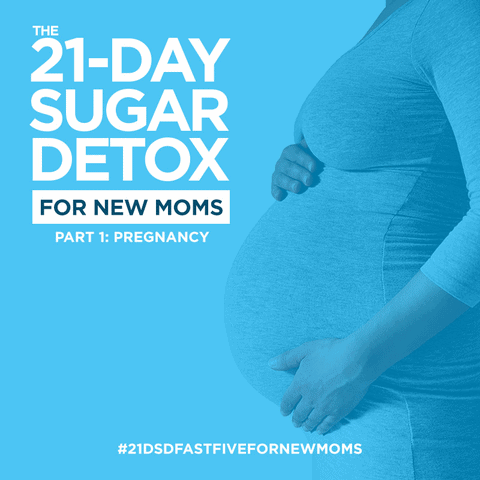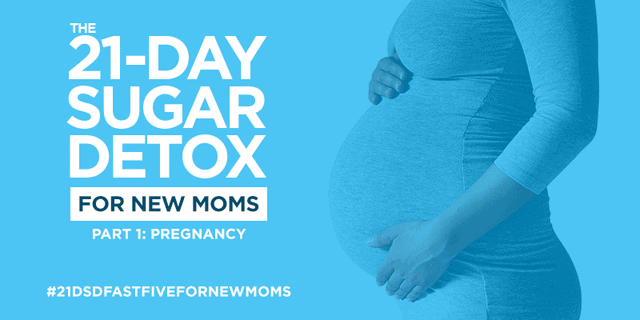Pregnancy is filled with many changes to a woman’s body. This peripartum period is often a time when women begin to reevaluate their diet and lifestyle to provide the best nutrition for their own bodies and those of their growing babies. Issues such as moderate to extreme hormonal changes, sleep deprivation, weight gain, and aches and pains add to women’s concerns and may lead to decisions about diets or dietary changes.
First, let me state that the 21DSD is perfectly safe for pregnant women. The focus is on real, whole food that is nutrient-dense, nourishing, and will provide enough satiety to bring you through this period. That said, are you wondering whether the 21DSD is right for you? Do you have questions about how to successfully complete the 21DSD while pregnant?
Our #21DSDFastFiveforNewMoms will help you rock your 21DSD!
Below you will find the top five tips and tricks for mastering the 21DSD while you are pregnant.
#1. Time it right!
 During the first trimester, your body is rapidly changing—you will likely feel extra tired, nauseated, and/or irritable. You may have morning (or all-day) sickness, and you may experience food aversions or sensitivities to food smells, textures, or flavors. You might be ravenous or not feel like eating at all. Because of this wide variety of responses to the changes in your body during early pregnancy, think carefully about whether this is the appropriate time for you to do a 21DSD. If you feel good on most days and have the energy to do the preparation needed to have a successful 21DSD (or a supportive partner/parent/friend who will cook for you), then go for it! Remember to add the dense carbs at each meal and your piece of fruit each day (see below).
During the first trimester, your body is rapidly changing—you will likely feel extra tired, nauseated, and/or irritable. You may have morning (or all-day) sickness, and you may experience food aversions or sensitivities to food smells, textures, or flavors. You might be ravenous or not feel like eating at all. Because of this wide variety of responses to the changes in your body during early pregnancy, think carefully about whether this is the appropriate time for you to do a 21DSD. If you feel good on most days and have the energy to do the preparation needed to have a successful 21DSD (or a supportive partner/parent/friend who will cook for you), then go for it! Remember to add the dense carbs at each meal and your piece of fruit each day (see below).
However, if you evaluate your life and see that you have many demands (work, older children, family issues, etc.) that divert your attention from self- care, you may want to wait to start your 21DSD until some of the more uncomfortable symptoms of early pregnancy subside. This doesn’t mean you should eat whatever you want or whatever crosses your path! You are growing a tiny human, and your food choices should reflect the nutrient density that will support your own body and that of your growing baby. Refined and artificial sugars of any kind have no place in a pregnancy diet. But this also means fruit may taste much better than vegetables, or that gluten-free crackers are all you really feel like eating. Do your best to eat good foods and don’t stress about the rest.
During the second and third trimester, you are likely feeling more energetic and less nauseated. Whoo-hoo! Now is a great time to begin a 21DSD and form some new habits that can carry you through the end of pregnancy and into the postpartum period. If you haven’t already done so, clean out your refrigerator and pantry of all NO foods and stock up—you’ll want to be prepared with lots of YES foods so that you don’t stray from the program when you are super hungry.
Cooking larger meals, pre-cutting vegetables, and making meals or snacks that can be frozen and easily reheated are invaluable ways to have healthy foods on hand at all times. And don’t get caught without snacks in your car or purse—pack some shelf- stable essentials like nuts/seeds, jerky, and coconut flakes for those on-the-go moments when YES foods aren’t easily accessible and you need something quick.
#2. Add some starchy vegetables to each meal.
You will be most successful doing the 21DSD while pregnant when you add sufficient activity carbs (starchy, dense carbohydrates) to support your body’s increased need for dense carbohydrates and energy.
Sweet potatoes, potatoes, pumpkin, acorn or butternut squash, plantains, etc. are starchy vegetables. Add ½ – 1 cup of these dense carbohydrates to each meal; the goal is to add 30–50g starchy carbs to each meal for a total of 90-150g per day. We also recommend that you eat either one green-tipped banana or one green apple each day as well. This will provide some extra carbohydrates and add to the variety of foods you can choose from.
#3. Make sure you are eating enough.
At some point during your 21DSD you may feel weak, fatigued, dizzy, or just less than your best. You may not be consuming enough calories or eating enough dense carbohydrates. A 21DSD-type eating plan focuses on protein, healthy fats, and vegetables, and while it does not have to be low-carb, you may be unwittingly reducing the amount of carbs you consume. Fat and protein are more satiating, so even if you don’t feel hungry, you may not be getting enough total calories. While you are pregnant, it is especially vital for you to make sure you are eating enough, so if you notice any of those symptoms, increase your total food intake and/or add in more starchy vegetables and see how you feel.
While the 21DSD is not a low-carb eating program, it can become one if you don’t include enough vegetables in your meals. While pregnant moms need adequate protein and fat, they also need the nutrients, fiber, and carbohydrates from vegetables (and fruit). People who eat low–carb diets tend to self–restrict calories because they feel satisfied. However, this can cause problems for pregnant women who need a certain level of calories in order to maintain adequate weight and provide sufficient nutrients for both mom and baby’s needs. While you may not feel as hungry following a 21DSD eating plan, you still need up to 2,700 calories per day or even more (depending on your height, weight, activity level, and nutritional status). While we don’t advocate counting calories for restrictive reasons, it is especially important for pregnant and breastfeeding women to consume enough calories on a regular basis to support your needs.
#4. Focus on building, not on losing.
The 21-Day Sugar Detox is fantastic for reducing cravings, changing habits, and focusing on eating nutrient-dense food, all of which are great goals for pregnancy, but the reality is that many people also lose weight. However, while pregnant, your focus is growing a tiny human; you don’t want to lose weight. Talk with your healthcare provider if you are planning to do a 21DSD so that he/she can help you track your weight and baby’s growth at regular checkups. Remember that you want to build: a strong body and mind for baby, a strong body and mind for you.
#5. Consider your activity.
You may also want to add in or maintain some activity during this time. Walking, yoga, and stretching are fantastic for early pregnancy. These types of activities will keep you moving and energized without overly fatiguing you. However, if you were rocking your CrossFit WODs or running every morning, and you’d like to continue that level of activity through pregnancy, make sure you are adding even more activity carbs to your meals (1/2 – 1 cup more!) to sustain your energy and help your body undergo all the amazing changes of pregnancy. As with any dietary changes, you should talk with your healthcare provider about the activity you plan to start or maintain throughout your pregnancy so that he/she can monitor the health and safety of both you and your baby.
We hope you found these tips and tricks helpful for rocking your 21DSD through pregnancy!
Are you a pregnant woman going through the 21-Day Sugar Detox right now? Do you have more questions about how to make your 21DSD successful? We’re here to help! Drop us a question in the comments below. We’d love to hear from you!
Stay tuned for Part 2 of our #FastFiveforNewMoms—The 21DSD and Breastfeeding.
 Rebekah Reddy is mom to her three children (two girls, one boy), content development support member of Team Diane, and a part-time high school English/ESL teacher. She holds a BA in English with a minor in Spanish, an MA in English with an emphasis in Teaching English to Speakers of Other Languages (TESOL), and a California teaching credential. She is also a certified Nutrition Educator, 21DSD Certified Coach, and the author of the blog Half Indian Cook through which she shares recipes and writes about food and culture in her mixed-ethnicity family. Rebekah’s passion for delicious, nutritious food has led her entire family to improved health and happiness!
Rebekah Reddy is mom to her three children (two girls, one boy), content development support member of Team Diane, and a part-time high school English/ESL teacher. She holds a BA in English with a minor in Spanish, an MA in English with an emphasis in Teaching English to Speakers of Other Languages (TESOL), and a California teaching credential. She is also a certified Nutrition Educator, 21DSD Certified Coach, and the author of the blog Half Indian Cook through which she shares recipes and writes about food and culture in her mixed-ethnicity family. Rebekah’s passion for delicious, nutritious food has led her entire family to improved health and happiness!


Comments 2
Thank you for this article, it is very helpful. I am on Day 3 now and am very excited. I did have a question about the recommended fruit suggestion above: Is grapefruit still an option and would it be a half? or just the banana OR green apple?
Author
Brittany,
Yes, grapefruit would still be an option. You could have a whole grapefruit or two halves of any combination of the approved fruits.
~Rebekah